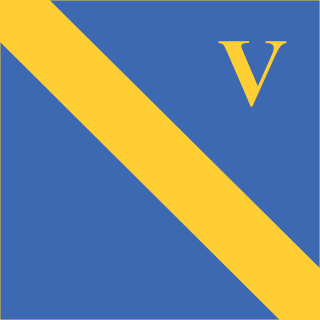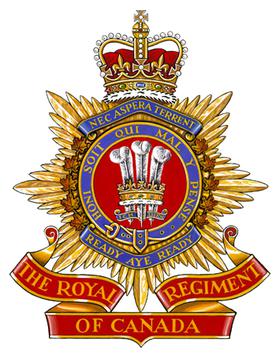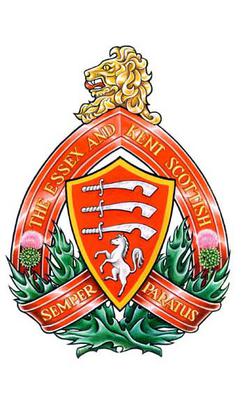
The 54th Infantry Division was an infantry division of the British Army. The division was raised in 1908 following the creation of the Territorial Force (TF) as the East Anglian Division. During the First World War the division fought at Gallipoli and in the Middle East. The division was disbanded after the war but reformed in the Territorial Army in 1920. During the Second World War it was a home service division and did not see any combat service abroad and was disbanded in late 1943 but many of its component units went to see service in the Normandy Campaign and North-western Europe from June 1944 to May 1945.

The 2nd Canadian Division, an infantry division of the Canadian Army, was mobilized for war service on 1 September 1939 at the outset of World War II. Adopting the designation of the 2nd Canadian Division, it was initially composed of volunteers within brigades established along regional lines, though a halt in recruitment in the early months of the war caused a delay in the formation of brigade and divisional headquarters. With questions concerning overseas deployment resolved, the division's respective commands were formed in May and June 1940, and at British Prime Minister Winston Churchill's request, the division was deployed to the United Kingdom between 1 August and 25 December 1940, forming part of the Canadian Corps.

The 5th Infantry Division was a regular army infantry division of the British Army. It was established by Arthur Wellesley, 1st Duke of Wellington for service in the Peninsular War, as part of the Anglo-Portuguese Army, and was active for most of the period since, including the First World War and the Second World War and was disbanded soon after. The division was reformed in 1995 as an administrative division covering Wales and the English regions of West Midlands, East Midlands and East. Its headquarters were in Shrewsbury. It was disbanded on 1 April 2012.

The Royal Regiment of Canada is a Primary Reserve infantry regiment of the Canadian Army. The regiment is based in Toronto, Ontario, and forms part of the 4th Canadian Division's 32 Canadian Brigade Group.

The 1st Canadian Division is a joint operational command and control formation based at CFB Kingston, and falls under Canadian Joint Operations Command. It is a high-readiness unit, able to move on very short notice, and is staffed and equipped to meet Canada's military objectives to counter any potential threat.

The 2nd Canadian Division is a formation of the Canadian Army in the province of Quebec, Canada. The present command was created 2013 when Land Force Quebec Area was re-designated. The main unit housed in this division is the Royal 22nd Regiment based at CFB Valcartier near Quebec City, which is the largest regiment in the Canadian Army.

The Essex Regiment was a line infantry regiment of the British Army in existence from 1881 to 1958. The regiment served in many conflicts such as the Second Boer War and both World War I and World War II, serving with distinction in all three. It was formed in 1881 under the Childers Reforms by the amalgamation of the 44th Regiment of Foot and the 56th Regiment of Foot.

The Royal Hamilton Light Infantry (Wentworth Regiment) (RHLI) is a Primary Reserve infantry regiment of the Canadian Army, based at John Weir Foote VC Armoury in Hamilton, Ontario. The RHLI is part of 31 Canadian Brigade Group, which is part of 4th Canadian Division.

The Essex and Kent Scottish is a Primary Reserve infantry regiment of the Canadian Army.

The 5th Canadian Infantry Brigade was an infantry brigade of the Canadian Army that fought during World War I and World War II. Raised in 1915, it formed part of the 2nd Canadian Division and fought on the Western Front during World War I before being disbanded. Later, it was re-raised in September 1939 and subsequently took part in Allied operations in north-west Europe in 1944 and 1945.

The 23rd Infantry Brigade was an infantry brigade of the British Army that saw active service in the First World War, mainly on the Western Front During the Second World War, the brigade saw active service in the Syria-Lebanon Campaign, the Western Desert Campaign, and the Burma Campaign.

The 7th Light Mechanised Brigade Combat Team is a formation in the British Army with a direct lineage to 7th Armoured Brigade and a history that stretches back to the Napoleonic Wars. It saw active service in the Crimean War, the Second Boer War and both the First and the Second World Wars. In 2014, the 7th Armoured Brigade was re-designated as 7th Infantry Brigade, thereby ensuring that the famed "Desert Rats" continue in the British Army's Order of battle.
The 163rd Infantry Brigade was an infantry brigade of the British Army that saw active service during the First World War in Gallipoli and the Middle Eastern Theatre as part of the 54th Division. In the Second World War the brigade remained in the United Kingdom until it was disbanded in late 1943.
The 25th Infantry Brigade was a war-formed infantry brigade of the British Army that saw active service during both the First and the Second World Wars.

The 29th Infantry Brigade was an infantry brigade unit of the British Army. It was originally raised in 1914 and saw service during the First and Second World Wars and the Korean War.
The 6th Canadian Infantry Brigade was an infantry brigade of the Canadian Army that fought during World War I and World War II. Raised in 1915, it formed part of the 2nd Canadian Division and fought on the Western Front during World War I before being disbanded. Later, it was re-raised in September 1939 and subsequently took part in Allied operations in north-west Europe in 1944 and 1945.

The Guards Division was an infantry division of the British Army that was formed in the Great War in France in 1915 from battalions of the Guards regiments from the Regular Army. The division served on the Western Front for the duration of the First World War. The division's insignia was the "All Seeing Eye".
The 156th Brigade was an infantry brigade formation of the British Army. The brigade saw active service in both the First and the Second World Wars with the 52nd (Lowland) Infantry Division.
21st Brigade was an infantry formation of the British Army first organised in the Second Boer War, when it took part in Ian Hamilton's March from Bloemfontein to Pretoria. Reformed in World War I it served under the command of first 7th Division and then 30th Division, fighting in most of the major battles on the Western Front from the First Battle of Ypres to the Armistice. It was briefly re-raised in the Sudan early in World War II before being transferred to the Indian Army.

The Essex Brigade, later 161st Brigade and 161st Infantry Brigade, was a volunteer infantry formation of the British Army in existence from 1888 until 1941, and again from 1947. It served at Gallipoli and in Palestine during the First World War and returned to Egypt in the early part of the Second World War before transferring to the British Indian Army and redesignated 161st Indian Infantry Brigade. In peacetime and during the wars the brigade was an integral part of the 54th Infantry Division and contained mostly battalions of the Essex Regiment.
















